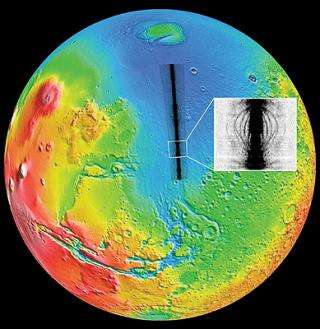Geologists finding a different Mars underneath

Scientists are finding an older, craggier face of Mars buried beneath the surface, thanks to pioneering sounding radar co-sponsored by NASA aboard the European Space Agency's Mars Express spacecraft.
In a paper published in the Dec. 14 issue of the journal Nature, researchers say radar echoes captured by the MARSIS (Mars Advanced Radar for Subsurface and Ionospheric Sounding) instrument strongly suggest there are ancient impact basins buried beneath the lowland smooth plains of the Martian northern hemisphere.
The project is the first-ever exploration of a planet by sounding radar. The paper's lead author, MARSIS science team member Thomas R. Watters of the Smithsonian National Air and Space Museum's Center for Earth and Planetary Studies, describes the work as “almost like having X-ray vision. Besides finding previously unknown impact basins, we've also confirmed that some of the subtle, roughly circular topographic depressions in the lowlands are related to impact features.”
The MARSIS instrument transmits radio waves that pass through the Martian surface and bounce off of features in the subsurface that have a contrast in electrical properties with the materials that buried them.
The difference in elevation and apparent age between the northern lowlands and southern highlands of Mars, known as the dichotomy, is among the most enduring mysteries about the geologic evolution of the planet. Watters says the new findings mean "that the northern lowland crust below the smooth plains is ancient, perhaps as ancient as the heavily cratered highland crust in the southern hemisphere.”
Martian lowland crust was buried first by vast amounts of volcanic lava and then by sediments carried by episodic flood waters and wind.
Source: Smithsonian





















